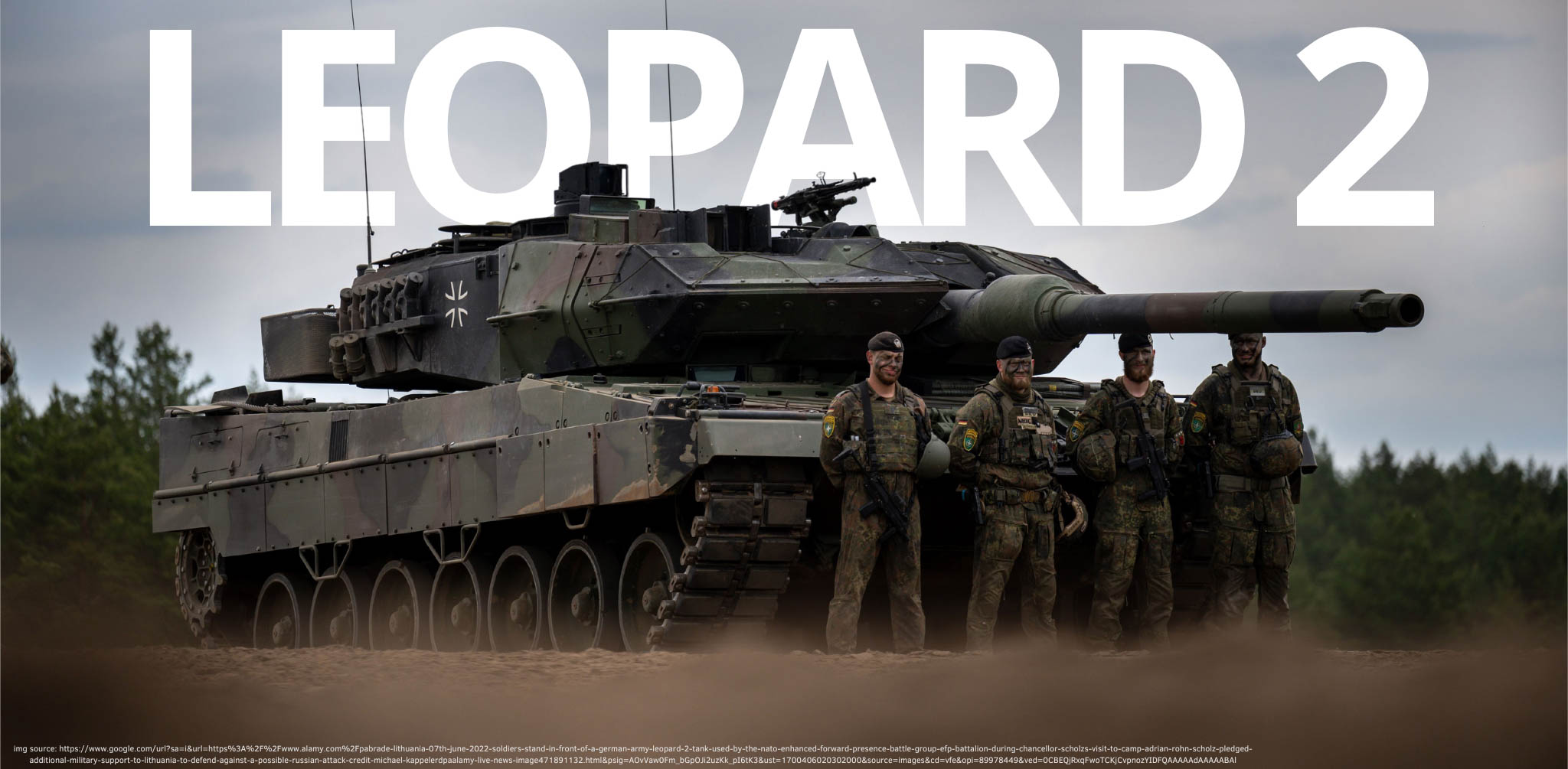

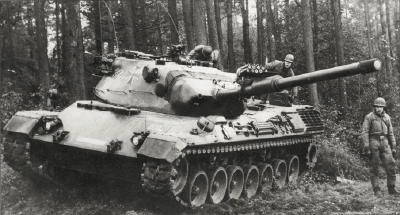
Even as the Leopard 1 was just entering service, the West German military was interested in producing an improved tank in the next decade. This resulted in the start of the MBT-70 development in cooperation with the United States beginning in 1963. However already in 1967 it became questionable whether the MBT-70 would enter service at any time in the foreseeable future. Therefore, the German government issued the order to research future upgrade options for the Leopard 1 to the German company Porsche in 1967.
This study was named vergoldeter Leopard (Gilded Leopard) and focused on incorporating advanced technology into the Leopard design. The projected upgrades added an autoloader, a coaxial autocannon and an independent commander's periscope. The anti-air machine gun could be operated from inside the vehicle and a TV surveillance camera was mounted on an extendable mast. The shape of the turret and hull was optimised using cast steel armour, while the suspension, transmission, and engine exhaust vents were improved.
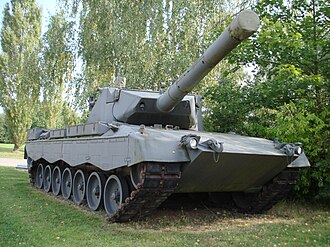
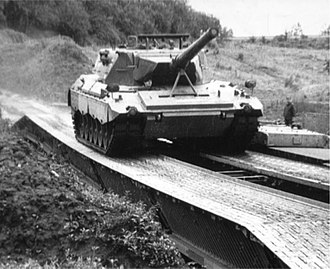
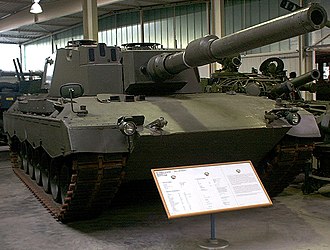
Following the end of the Gilded Leopard study in 1967, the West German government decided to focus on the Experimentalentwicklung (experimental development) in a feasibility study and to develop new components for upgrading the Leopard 1 and for use on a future main battle tank programme. At first 25 million DM were invested, but after the industry came to the conclusion that with such a low budget the development of the two projected testbeds was not possible, a total of 30 to 32 million DM was invested. The experimental development was contracted to the company Krauss-Maffei, but with the obligation to cooperate with Porsche for the development of the chassis and with Wegmann for the development of the turret.
Two prototypes with different components were built with the aim of improving the conception of Leopard 1 in such a way that it would match the firepower requirements of the MBT-70. A high first-hit probability at ranges of 2,000 metres (6,600 ft) and the ability to accurately engage targets on the move using a computerised fire control system were the main goals of the experimental development. The resulting vehicles were nicknamed Keiler ("tusker"). Two prototypes (ET 01 and ET 02) of the Keiler were built in 1969 and 1970, both of them being powered by the MB 872 engine.
The MBT-70 was a revolutionary design, but after large cost overruns and technological problems, Germany withdrew from the project in 1969. After unsuccessful attempts at saving the MBT-70 by conceptual changes in order to eliminate the biggest issue—the driver being seated in the turret—it became clear in late 1969 that Germany would stop the bi-national development. The assistant secretary of the military procurement division of the German Ministry of Defence suggested reusing as many technologies developed for the MBT-70 as possible in a further programme, which was nicknamed Eber ("boar") due to his being named Eberhardt. The Eber used a modified MBT-70 turret and hull, with the driver being seated in the hull. Only a wooden mock-up was made.
One year later, a choice was made to continue the development based on the earlier Keiler project of the late 1960s, instead of finishing the development of the Eber. In 1971, the name of the design was determined as Leopard 2 with the original Leopard retroactively becoming the Leopard 1, and Paul-Werner Krapke became the project officer of the Leopard 2 program. Originally two versions were projected: the gun-armed Leopard 2K and the Leopard 2FK, which would be armed with the XM150 gun/launcher weapon of the MBT-70.
In 1971, 17 prototypes were ordered but only 16 hulls were built as the production of hull PT12 was cancelled. Ten were ordered initially before another seven were ordered. The 17 turrets were designated T1 to T17, and the hulls were designated PT1 to PT11 and PT13 to PT17. To test a larger number of components and concepts, each prototype was fitted with components not found on the other prototypes. Ten of the turrets were equipped with 105 mm smoothbore guns and the other seven prototypes were equipped with a 120 mm smoothbore gun.
Hulls PT11 and PT17 were fitted with a hydropneumatic suspension based on the MBT-70 design. The running gears of these two hulls had only six road wheels. Different types of auxiliary power units (APUs) were mounted in the prototypes. All turrets were equipped with a machine gun for air defence, except the turret mounted on PT11, where a 20 mm remotely operated autocannon was mounted. With the exception of hulls PT07, PT09, PT15, and PT17, all prototypes used the MB 873 engine. The road wheels were taken from the MBT-70 and the return rollers from the Leopard 1. The prototypes were designed with a projected weight of MLC50, which equals approximately 47.5 tonnes (46.7 long tons; 52.4 short tons). The welded turret utilised spaced armour formed by two steel plates. The prototypes were equipped with an EMES-12 optical rangefinder and fire control system, which later was adopted on the Leopard 1A4.
In mid-1973 a new turret was designed by Wegmann saving 1.5 tonnes (1.7 short tons) in weight. It was nicknamed the Spitzmaus-Turm (shrew turret) due to the highly sloped front. This design was only possible with the new EMES-13 optical rangefinder, which required a base length of only 350 millimetres (14 in) instead of the previous 1,720 millimetres (68 in). Based on experiences in the Yom Kippur War, a higher level of protection than the prototypes' heavily sloped spaced armour was demanded in late 1973 and the Spitzmaus-Turm was never produced.
The weight limit was increased from MLC50 to MLC60, which equals approximately 55 tonnes (54 long tons; 61 short tons). The T14 turret was modified to test a new armour configuration, taking on a blockier-looking appearance as a result of using vertical modules of spaced multilayer armour. It was also used to test the new EMES-13 optical rangefinder. The modified T14 turret was designated T14 mod. and was fitted with a fully electric turret drive and stabilization system, which was developed jointly by General Electric and AEG Telefunken.
In July 1973 German Federal Minister of Defence Georg Leber and his US counterpart James R. Schlesinger agreed upon a higher degree of standardisation in main battle tanks being favourable to NATO. By integrating components already fully developed by German companies for the Leopard 2, the costs of the XM1 Abrams, U.S. prototype tank developed after the MBT-70, could be reduced. A German commission was sent to the US to evaluate the harmonisation of components between the XM1 and Leopard 2. However, under American law it was not possible for a public bidder to interfere in a procurement tender after a contract with intention of profits and deadline was awarded to private sector companies.
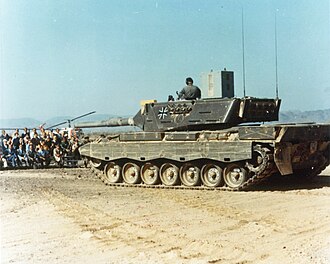
As a result, the modification of the Leopard 2 prototypes in order to meet the US Army requirements was investigated. Following a number of further talks, a memorandum of understanding (MOU) was signed on 11 December 1974 between Germany and the US, which declared that a modified version of the Leopard 2 should be trialed by the US against their XM1 prototypes, after the Americans had bought and investigated prototype PT07 in 1973. The MOU obliged the Federal Republic of Germany to send a complete prototype, a hull, a vehicle for ballistic tests and a number of special ballistic parts to the US, where they would be put through US testing procedures for no additional costs.
The Leopard 2AV (austere version) was based on the experiences of the previous Leopard 2 development. It was created in order to meet the US requirements and the latest protection requirements of the German MoD. The T14 mod turret was used as the base for the Leopard 2AV's turret, but meeting the required level of protection for the hull required several attempts until the final ballistic trials on 23 to 26 June 1976. Following the US' preference of laser rangefinders, the turret of prototype PT19 was fitted with a laser rangefinder developed together with the American company Hughes.
In comparison with the earlier Leopard 2 prototypes, the fire control system was simplified by replacing the EMES-12 optical rangefinder and removing the crosswind sensor, the air pressure and temperature sensors, the powder temperature sensor, the PERI R12 commander sight with IR searchlight, the short-range grenade launcher for use against infantry, the retractable searchlight, the spotlight, the retractable passive night vision sight, the APU and the mechanical loading assistant.
Due to the design and production of the Leopard 2AV taking more time than expected, the shipment to the US and the US evaluation was delayed. It was not possible to test the Leopard 2AV before 1 September 1976. Despite the German wish that the Leopard 2AV and the XM1 prototypes would be evaluated at the same time, the US Army decided not to wait for the Leopard 2AV and tested the XM1 prototypes from Chrysler and General Motors beforehand
Two new prototype hulls and three turrets were shipped to the US: PT20 mounting a 105 mm rifled L7 gun and a Hughes fire control system, PT19 with the same fire control system but able to swap out the gun for the 120 mm Rheinmetall smoothbore gun, and the PT21 fitted with the Krupp Atlas Elektronik EMES-13 fire control system and the 120 mm Rheinmetall gun. The Leopard 2AV fully met the US requirements. A study made by the American FMC Corporation showed that it was possible to produce the Leopard 2AV under licence in America without exceeding the cost limits set by the US Army. Before the trials were finished, it was decided that instead of the US Army possibly adopting the Leopard 2AV, the focus was shifted to the possibilities of common components between the two tanks. FMC, after having acquired the licenses for the production of the Leopard 2AV, decided not to submit a technical proposal, as they saw little to no chance for the US Army adopting a vehicle not developed in the US.
The US Army evaluation showed that on the XM1 a larger portion of the tank's surface was covered by special armour than on the Leopard 2AV. Differences in armour protection were attributed to the different perceptions of the expected threats and the haste in which the Leopard 2AV was designed to accommodate special armour. On mobility trials the Leopard 2AV performed equal to better than the XM1 prototypes. The AGT-1500 turbine engine proved to consume about 50% more fuel and the Diehl tracks had a higher endurance, while the tracks used on the XM1 prototypes failed to meet the Army's requirements.The heat signature of the MTU diesel engine was much lower. The fire control system and the sights of the Leopard 2 were considered to be better and the 120 mm gun proved to be superior. The projected production costs for one XM1 tank were $728,000 in 1976, and the costs for one Leopard 2AV were $56,000 higher
After the American evaluation of the Leopard 2AV and the US Army's decision to opt for the XM1 Abrams, both American and German sources blamed the other side. According to American literature, it was discovered that the Leopard 2AV prototype used for mobility trials was underweight.
In Germany, the test conditions were criticised for being unrealistic and favouring the XM1. Instead of using actual performance data, the calculated hypothetical acceleration was used. The XM1 was found to have a slightly higher rate of fire despite having internal layouts similar to the Leopard 2AV because the XM1 prototypes were manned by professional crews, while the Leopard 2AV had to be manned by conscripts in order to prove that the Leopard 2AV was not too complicated. Firing on the move was demonstrated on flat tracks, which nullified the better stabilization systems of the Leopard 2AV.

The decision to put the Leopard 2 tank in production for the German army was made after a study was undertaken[when?], which showed that adopting the Leopard 2 model would result in a greater combat potential of the German army than producing more Leopard 1A4 tanks or developing an improved version of the Leopard 1A4 with 105/120 mm smoothbore gun, improved armour protection, a new fire control system and a 890 kilowatts (1,190 hp) or 1,100 kilowatts (1,500 hp) engine. Various changes were applied to the Leopard 2 design before the series production started in 1979. The engine, transmission, and suspension were slightly modified and improved. The ballistic protection of the turret and hull was improved and weak spots were eliminated.
The turret bustle containing the ready ammunition racks and the hydraulic system was separated from the crew compartment and fitted with blowout panels. The development of several new components was introduced to the Leopard 2 during the Leopard 2AV development and after the US testing was completed. For the series version, the Hughes-designed laser rangefinder made with US Common Modules was chosen over the passive EMES-13 rangefinder. The EMES-13 system was considered to be the superior solution, but the Hughes system was cheaper and fully developed.
The German company Krupp-Atlas-Elektronik acquired the licence of the Hughes design and modified it to meet the needs of the German army. The modified rangefinder received the designation EMES-15. The installation of the US AGT-1500 turbine engine in the Leopard 2 was tested by MaK. The AGT-1500 was from the United States and required deep modifications to the Leopard 2's chassis. However, driving tests at the WTD 41 revealed a number of drawbacks such as high fuel consumption and the poor performance of the transmission including the brakes. This project was thus terminated.
In January 1977 Germany ordered a small pre-series of three hulls and two turrets which were delivered in 1978. These vehicles had increased armour protection on the front of the hull. One of the hulls was fitted with the earlier T21 turret and was used by the German army school in Munster for troop trials until 1979. In September 1977, 1800 Leopard 2 tanks were ordered, to be produced in five batches. The main contractor was Krauss-Maffei, but Maschinenbau Kiel (MaK) was awarded a contract for producing 45% of the tanks. The first batch consisted of 380 tanks. The delivery of six tanks was scheduled for 1979, 114 for 1980, 180 for 1981, and 300 tanks each following year.
The first series-production tank was delivered on 25 October 1979. By 1982, all of the first batch of 380 Leopard 2 tanks had been completed. 209 were built by Krauss-Maffei (chassis no. 10001 to 10210) and 171 by MaK (chassis no. 20001 to 20172). The first production tanks were fitted with the PzB-200 image intensifier due to production shortages of the new thermal night-sight system, which was later retrofitted to the earlier models. After the original five batches, three further batches of Leopard 2 tanks were ordered, increasing the number of Leopard 2 tanks ordered by Germany to a total of 2125. The sixth batch was ordered in June 1987 and consisted of 150 tanks, which were produced between January 1988 and May 1989. The seventh batch of 100 tanks was produced between May 1988 and April 1990. The last batch for the German army totalling 75 tanks was produced from January 1991 to March 1992.
During its production run during the Cold War, 16 Leopard 2 tanks were being produced per month. The vehicles were produced at a slower rate in the following decades, however KMW still retained the capacity to return to such manufacturing levels should they need to be made again at a higher rate and supply chains are able to deliver sufficient materials.
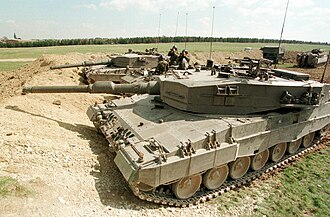
While previous models only varied in detail, the Leopard 2A4 introduced a digital ballistic computer and an improved fire extinguishing system. Starting with the sixth batch, tanks were fitted with an improved armour array and new side skirts. In 1984 the German military procurement agency stated a number of requirements for a future Leopard 2 upgrade. In 1989, the Kampfwertsteigerung (combat potential improvement) programme was initiated in Germany with the delivery of first prototypes. The official military requirements were published in March 1990.
The KWS programme was projected to consist of three stages. The first stage replaced the Rheinmetall 120 mm L/44 gun barrel and the corresponding gun mount with a longer barrelled and more lethal L/55 version.This stage was adopted in the form of 225 Leopard 2A6 tanks, starting in 2001 and lasting until 2005. Stage 2 focused on improvements of armour protection and survivability: it was adopted in the form of the Leopard 2A5, starting in 1995. The base armour of the tank was exchanged and additional armour modules were installed at the turret. The first batch of 225 Leopard 2 tanks was upgraded to Leopard 2A5 configuration between 1995 and 1998; a second batch of 125 followed from 1999 to 2002.
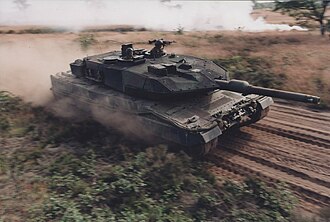
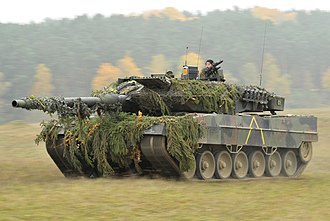
The third stage was the planned replacement of the Leopard 2 turret by a new turret fitted with a 140 mm NPzK tank gun, an autoloader, and the IFIS battlefield management system. The ballistic protection at the hull was to be improved. Originally a total requirement for 650 Leopard 2 tanks with KWS 3 was projected. It was never finalised, but the 140 mm NPzK tank gun was tested on an older prototype. In 1995 it was decided to cancel due to changes in the political environment. The funds were redirected to the Neue Gepanzerte Plattformen (New Armoured Platforms) project of the German army. The Leopard 2A6M was developed with a kit providing enhanced protection against mines that can detonate below the hull (like mines with bending wire triggers) and explosively formed penetrator mines. The weight of the Leopard 2A6M is 62.5 tonnes.
The latest version of the tank is the Leopard 2A7, which entered service in an initial batch of 20 tanks in 2014. Already before the first Leopard 2A7 tank was handed over to the German Army, plans for upgrades were made. At this time an "extensive" increase in combat value, while retaining the original mobility of the Leopard 2, was planned. The optics of the tank will also be improved.
In April 2015, Welt am Sonntag claimed that tungsten (wolfram) rounds used in Leopard 2 cannot penetrate the Russian T-90 or the modernized version of the T-80. They also stated that the German military will develop a new improved round, but it will be exclusively developed for the Leopard 2A7.
In 2015 Rheinmetall disclosed that it was developing a new 130 mm smoothbore gun for the Leopard 2 tank and its successor. This gun will offer a 50% increase in performance and penetration. Marketing for the new gun was slated to begin in 2016.
The Leopard 2 first entered service in 1979, and its service life is anticipated to end around 2030. In May 2015, the German Ministry of Defence announced plans to develop a tank jointly with France as a successor to both the Leopard 2 and Leclerc tanks. Technologies and concepts will be investigated to determine what capabilities are needed in a future tank. Deployment of the new tank, titled Main Ground Combat System (MGCS), will be preceded by incremental upgrades to the Leopard 2, including a new digital turret core system and situational awareness system and an active protection system (APS).
A short-term lethality increase will come from a higher pressure 120 mm gun firing new ammunition, expected to deliver 20 percent better performance than the L/55. Mid-term efforts will focus on a Rheinmetall 130 mm cannon concept offering 50 percent better armour penetration. With the Russian T-14 Armata being equipped with the Afghanit, an active protection system designed to mitigate the effectiveness of ATGM, more importance is being placed on direct-fire weapons.
Germany has fielded about 2,125 Leopard 2 main battle tanks in various versions, but many were sold following German reunification. The Leopard 2 became very popular in the 1990s, when the shrinking German army offered many of its redundant Leopard 2s at a reduced price. It became successful enough in Europe that the manufacturer started calling it the Euro Leopard, despite France, Britain, and Italy all operating their own MBTs. With further non-European orders, the name "Global-Leopard" is now used instead. Leopard 2 tanks have also been resold by original export customers, although reexport has always been conditional on consent from the German government who control the platform's export licence. Other countries have bought newly manufactured vehicles or have produced them locally under licence.
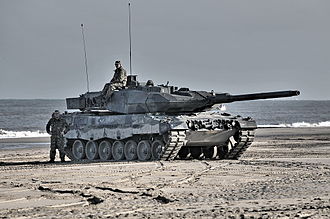
The Netherlands ordered 445 Leopard 2 tanks on 2 March 1979, after examining the results of the Leopard 2AV in the United States. It became the first export customer of the Leopard 2 and the vehicles were delivered between July 1981 and July 1986. Dutch Leopard 2 tanks have been subsequently exported to Austria, Canada, Norway, and Portugal. Leopard 2 tanks remaining in Dutch service have been upgraded to 2A5 and 2A6 standards.
The Swiss Army decided to purchase Leopard 2 tanks over the M1A1 Abrams after trialling both tanks between August 1981 and June 1982. The Swiss decision was made in August 1983 and the funding was approved by the government in 1984. Thirty-five of the tanks were delivered by Kraus-Maffei by June 1987. Eidgenössische Konstruktionswerkstätte Thun started license production of 345 additional vehicles in December 1987.
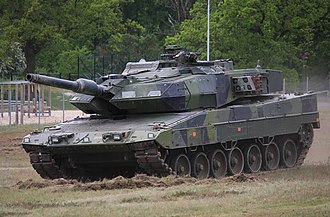
After investigating the option of a locally developed replacement for the Strv 103 tank, Sweden decided to buy a foreign tank model. The Leopard 2 Improved (Leopard 2A5 prototype) won the competition against the M1A2 Abrams and the French Leclerc. The Swedish military also evaluated the Soviet T-80U tank, but separately from the other tanks. After intensive tests from January to June 1994, the Swedish military opted for the Leopard 2. The Swedish military found that the Leopard 2 Improved met their military demands by 90%. The M1A2 met the Swedish requirements by 86%, whereas the Leclerc met 63%. In June 1994 Sweden ordered the production of 120 modified Leopard 2A5, to be known as Stridsvagn 122 (Strv 122) in Swedish service. Strv 122 features Swedish-developed appliqué armour, a new command system, and improved electronics. Of the 120 Strv 122, 29 were manufactured in Germany by Krauss-Maffei Wegmann while the other 91 were manufactured by the Swedish firms Bofors and Hägglunds. The first Stridsvagn 122 was delivered in December 1996. These remain in Swedish service and have received periodic upgrades.
.jpg)
Sweden also leased and later bought a total of 160 Leopard 2A4 tanks in 1994 and 1995, known in Swedish service as Stridsvagn 121 (Strv 121). The first Strv 121 was delivered in February 1994. The Strv 121 fleet was mothballed by 2006. Sweden has retained a number of Strv 121 tanks as training aids; 6 Strv 121 have since been converted into AEV 3 Kodiak armoured engineering vehicles, and a further 6 have been converted into Leguan armoured bridgelayers.
Denmark bought 51 ex-German Leopard 2A4 tanks after the Danish military school, the Hærens Kampskole, recommended basing the adoption of a new tank on the Swedish army trials. The first tanks were delivered in 1998, but the upgrade to Leopard 2A5 level was already decided the next year. In 2004-2006 the Danish army bought another six ex-German Leopard 2 tanks.
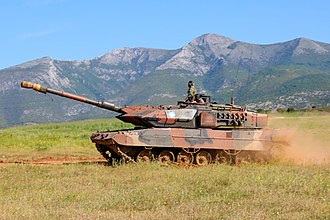
In 1998, Greece held a competition to determine the main battle tank for the Hellenic Army. The Leopard 2 Improved managed to outperform the Challenger 2E, Leclerc, M1A2 Abrams, T-80U, and T-84 and was chosen by the Greek officials. In March 2003 Greece ordered 170 Leopard 2 tanks, of which 140 were locally assembled. Greece also bought 183 Leopard 2A4 and 150 Leopard 1 tanks.
Spain initially leased 109 Leopard 2A4 tanks, after Krauss-Maffei withdrew from the Lince development, a special lighter version of the Leopard 2 developed together with Santa Bárbara Sistemas. Before the end of the Lince tank, Spain had already rejected the M1A1 Abrams and the Vickers Valiant. After deciding to purchase the leased tanks, Santa Bárbara Sistemas acquired the licence to locally produce 219 Leopard 2A6 tanks for the Spanish army.
Poland received 128 Leopard 2A4 tanks from German army stocks in 2002. In 2013 Poland ordered a further 119 ex-German Leopard 2s. Finland bought 124 used Leopard 2A4 tanks and six armoured bridge-layer Leopard 2L tanks from Germany in 2002 and 2003. The tanks served as replacements for the old Soviet-made T-55 and T-72M1. The Netherlands resold 114 of their tanks (and one turret) to Austria, 80 to Canada in 2007, 52 to Norway, 37 to Portugal and 100 to Finland.
In December 2018, Hungary placed an order for 44 Leopard 2A7+s and 12 second-hand 2A4s. The order coincided with the procurement of 24 Panzerhaubitze 2000, and was expected to replace Hungary's current fleet of T-72 tanks "no sooner than 2020".
In February 2023, the Norwegian Prime Minister, Jonas Gahr Stoere, announced that Norway would be ordering 54 new Leopard 2A7 tanks at a cost of NKr 19.7 billion with a further option for 18 vehicles to be delivered at a later date. The first Leopard 2A7s are due to be delivered by 2026, and operational by 2031. The Norwegian government had been weighing up either the Leopard 2A7 or the South Korean K2 Black Panther as a replacement for its aging Leopard 2A4 fleet. The tanks will be designated Leopard 2A8 NOR.
In 2005, Turkey ordered 298 Leopard 2 tanks from German army stocks. The Leopard 2 was chosen in 2001 after successfully competing one year earlier in the Turkish army trials against the T-84 Yatagan, Leclerc and a version of the M1A2 Abrams fitted with a German MTU diesel engine. Turkey wanted to buy 1,000 Leopard 2 tanks in 1999, but the German government rejected the deal.
Singapore bought 96 Leopard 2 tanks from Germany in 2006. Chile bought 172 ex-German Leopard 2A4 tanks and 273 Marder 1A3 IFVs in 2007.
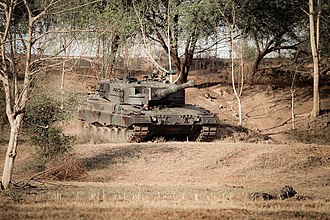
Indonesia ordered 103 Leopard 2 tanks and 42 Marder 1A3 IFVs in 2013. At first the export of heavy weapons to Indonesia was not allowed by the German government, due to the questionable human rights record of Indonesia. 61 of the 103 Leopard 2 tanks will be upgraded by Rheinmetall to the Leopard 2RI standard, based on Rheinmetall's Revolution modular upgrade concept.
Qatar ordered 62 Leopard 2A7 tanks and 24 Panzerhaubitze 2000s in 2013. The delivery of the tanks started in late 2015 and the first tanks were displayed on a military parade in December 2015.
On 2 July 2023 Ukraine had reportedly received 54 Leopard 2A4 from NATO-member countries
Since April 2022, in the wake of the Russian invasion, the Ukrainian government has requested that their allies donate Western-made main battle tanks. Poland, Finland and others have all announced a willingness to contribute Leopard 2 tanks from their stocks, with around 100 tanks from various states ready to be transferred to Ukraine. However, when Germany exported the tanks to these countries, it had made reexport conditional on a German government permit, as based on the Kriegswaffenkontrollgesetz and Außenwirtschaftsgesetz. Until 22 January 2023, it was unclear whether such a consent would be provided with Germany determined to avoid any perception of escalating the conflict, and wary of being labelled an aggressor. Germany has also been keen to extract an American commitment to provide its own M1 Abrams tanks, before sending German-made Leopard 2 tanks to Ukraine.
The matter was discussed at a conference of defence ministers from NATO members and allies, but no agreement was reached. The German position was heavily criticized by some of the other European governments with Poland threatening to unilaterally export their Leopards if permission from Berlin was not given. The Polish and Ukrainian governments then announced that Ukrainian soldiers would start training on Polish Leopard 2 tanks in Poland.
On 22 January 2023, the German minister for foreign affairs, Annalena Baerbock, told French media that Germany "would not stand in the way" of any Polish decision to send Leopard 2 tanks to Ukraine but noted that "for the moment the question has not been asked." Two days later, Poland made an official request for permission to transfer Polish Leopards to Ukraine.
On 24 January Der Spiegel reported that the German Chancellor, Olaf Scholz, would the following day, officially announce the transfer of an undisclosed number of German Leopard 2 tanks to Ukraine, beginning with 14 Leopard 2A6s from the active Bundeswehr inventory. The German government would also give permission to any country seeking to reexport Leopard 2 tanks to Ukraine. These reports were formally confirmed by the German government on 25 January.
It was also reported that Boris Pistorius, the German defence minister, was encouraging Leopard-operating states to start training Ukrainian personnel in their use.
The German decision to provide and approve the provision of Leopard 2 tanks to Ukraine came after U.S. President Joe Biden decided to provide Ukraine with M1 Abrams tanks, as Germany insisted on moving in coordination with its allies. The decision to provide M1 Abrams tanks had previously been opposed by the Pentagon.
On 15 February 2023, Pistorius expressed his frustration at Germany's allies in their announcement of any donations of Leopard 2 tanks to Ukraine, saying it had "not been exactly breathtaking, to put it mildly." Since the change in German position on exports, only Poland had matched the German promise to provide 14 tanks - the two largest donations from a single country.
On 25 January 2023, the German government confirmed that it would make 14 Leopard 2A6 (a company-strength number) available for Ukraine and would give authorisation to European partners to reexport their vehicles. The goal is for European Leopard 2 operators to provide two battalions worth, or 88 tanks, to Ukraine.
According to the German government, the tanks will be delivered to Ukraine after training Ukrainian service personnel. This process would take up to three months. Some tanks are held by the Bundeswehr, others by the Leopard manufacturer Rheinmetall. The latter has said they could be ready to be dispatched by March 2023. However, they also warned that some vehicles held in long-term storage would require extensive refurbishment and updating before they could be considered suitable for combat in Ukraine. On 26 January, Pistorius, the German minister of defense, stated that the tanks would be delivered in late March or early April. On 24 February 2023, the German Department of Defence confirmed Germany would increase its Leopard 2A6 contribution from 14 to 18, thus providing 1 full tank battalion together with the contributions of Portugal and Sweden.
On 27 March 2023, Germany delivered 18 Leopard 2A6 tanks to Ukraine with two accompanying armoured recovery vehicles and necessary spare parts.
On 28 March 2023, the security board of the Swiss National Council recommended that 25 Leopard 2 in storage should be sold to the German manufacturer Krauss-Maffei-Wegmann so that Germany can replace some of its own tanks now serving in Ukraine. As of this day, Switzerland keeps 96 Leopard 2 in storage. As the tanks' sale requires decommissioning, the Bundeswehr waits for approval by the Swiss parliament.
On 27 September 2023, the Swiss parliament has voted to decommission 25 Leopard 2 tanks, allowing them to be sold back to Germany. Germany has given assurances that ex-Swiss tanks will not be sent to Ukraine.
Poland welcomed the German decision to allow the transfer of Leopard 2 tanks to Ukraine, with the Polish government announcing on 25 January it would transfer 14 Leopards to Ukraine from a total Polish stock of 247, in addition to a further 50–60 Soviet-era tanks. On 24 February 2023, the first 4 Leopard 2A4 tanks from Polish stocks were delivered to Ukraine. These are the first Leopard 2 tanks to be operated by Ukraine.
On 26 January 2023, the Canadian Defence Minister, Anita Anand, announced that Canada would be sending four Leopard 2A4 tanks to Ukraine, with the potential for more to follow. These vehicles were reportedly 'combat ready.' Canada will also provide appropriate training to Ukrainian forces who will go on to operate these tanks. The first Canadian Leopard 2 tanks had arrived in Poland on 5 February, to allow Ukrainian troops to begin training. On 24 February, the Canadian Prime Minister, Justin Trudeau, announced that Canada would be sending a further four Leopard 2A4 tanks to Ukraine along with 1 armoured recovery vehicle (ARV) and 5,000 rounds of ammunition.
On 20 January 2023 the Czech Defense Ministry issued a statement that the media reports indicating the Czech Republic and Slovakia were willing to give up their Leopard 2 tanks for Ukraine were false, and that rumors that the Czech Republic would receive American Abrams tanks in exchange for Leopards were also false. As of December 2022, both countries had only received 1 Leopard 2A4 each from Rheinmetall as part of Germany's Ringtaush program in exchange for them delivering older Soviet equipment to Ukraine, while the remaining Leopard 2A4s are still being refurbished (expected to be delivered throughout 2023).
While it was reported in the international press that Denmark had signalled that it could contribute a number of tanks, there was no official indication from the Danish Government that any Danish Leopard 2's would be sent to Ukraine. Of the Danish inventory of 44 tanks, 14 were deployed to Estonia as part of NATO EFP, with a further number receiving upgrades at the German manufacturers. Some Danish opposition politicians voiced support for a transfer of Danish tanks. Unlike those considered by other countries, the Danish Leopards are of the new 2A7 standard, which would represent some logistic and mechanical challenges compared to the other variants. Denmark instead announced on 7 February that it was jointly purchasing 100-178 Leopard 1A5 tanks with Germany and the Netherlands. Denmark also announced on 20 April 2023 that they would jointly finance with the Netherlands the purchase and refurbishing of 14 Leopard 2A4 for Ukraine from private industry stocks.
Finland had suggested before the German decision on reexport, that it could supply Ukraine with a limited number of Leopard 2 tanks. The Finnish President, Sauli Niinistö, warned that "the number of tanks [to be sent to Ukraine] cannot be large, since Finland borders on Russia and is not part of NATO." On 23 February Finland announced it will give 3 Leopard 2R mine clearing vehicles to Ukraine. Finnish total stock of this type will return the same (6) with planned purchase of 3 replacement vehicles from Germany.
On 25 January 2023 it was reported that Greece was one of the countries that had indicated it would supply Leopard 2 tanks to Ukraine. On 29 January 2023 it was erroneously reported that approximately 14 Leopard 2 tanks would be provided, though it was unclear if it would be the 2A4 or 2A6 HEL variant. However, on 31 January, Greek Prime Minister Kyriakos Mitsotakis clarified that Greece would not supply any Leopard tanks to Ukraine, arguing "they are absolutely necessary for our defense posture."Leaked Pentagon documents revealed that Greece was preparing to donate 5 of its Leopard 2 tanks to Ukraine, though Greek defense minister Nikolaos Panayiotopoulos reiterated later in April his government's opposition to tank deliveries to Ukraine, making confirmation of the delivery uncertain.
The Netherlands was considering Ukrainian requests for Leopard 2 tanks, with Prime Minister Mark Rutte suggesting that the Dutch government could purchase tanks from other countries and donate them. There were also some discussions about Netherlands purchasing the 18 Leopard 2A6 tanks they lease from Germany. No refusal was made from Germany to sell them as no formal request to buy them was made; both countries agreed that they were critical to the operations of the joint German-Dutch military unit. However, the Netherlands agreed to supply ammunition for Leopard tanks and announced it had not abandoned its intention to contribute to the tank initiative, while also noting it was helping to purchase Leopard 1A5 tanks with Denmark and Germany. The Netherlands later announced it was jointly financing with Denmark the purchase and refurbishing of 14 Leopard 2A4 for Ukraine from private industry stocks, with delivery expected in early 2024.
On 25 January 2023, Norway pledged to donate spare Leopards to Ukraine with reports speculating that between four and eight of its 36 Leopard 2A4 tanks would be sent. Norwegian defence minister Bjørn Arild Gram said in an interview with Norwegian public television NRK: "Norway and the government support the donation of battle tanks to Ukraine. Norway will take part," but did not specify how many would be sent. On 14 February 2023, Gram announced that 8 Norwegian Leopard 2 tanks and 4 Leopard 1 derived "special purpose vehicles" would be handed over to Ukraine. The special purpose vehicles turned out to be a mix of 3 NM189 AEVs and 1 NM217 ARV. In February 2023, Norway ordered 54 Leopard 2A7 tanks (later changed to 2A8 variant) to be delivered from 2026, with a further option for 18 vehicles if necessary.
When the German government changed its position on the reexport of Leopard 2 tanks, it was reported that the Portuguese government was preparing to send four of their Leopard 2A6 tanks to Ukraine. On 4 February, Prime Minister António Costa confirmed that Portugal would send Leopards to Ukraine, but did not confirm the number of vehicles set to be delivered. It is understood that Portugal is working with Germany to obtain the necessary parts to repair inoperable tanks in its inventory of 37 Leopard 2 tanks, but it has been widely reported by local media that most are inoperable. Costa expressed hopes that Portuguese tanks would be delivered by March 2023. On 14 February, it was reported that Portugal had earmarked 3 Leopard 2A6 tanks for donation to Ukraine. All 3 were confirmed donated on March 27 together with the 18 German Leopard 2A6.
On 25 January 2023, Slovakia announced it was not considering the transfer of any of its Leopard 2A4 tanks to Ukraine, but were willing to provide T-72 tanks if other allies replaced them with other tanks. The reason cited for this was that Slovakia had only received 1 of the 15 Leopard tanks it was promised as part of Germany's Ringtaush program, which it was getting in exchange for supplying Ukraine with 30 Soviet-era infantry fighting vehicles.
On 4 June 2022 it was reported that Spain was considering providing 40 of its 53 retired Leopard 2A4 tanks stored in Zaragoza. On 8 June German Chancellor Olaf Scholz denied receiving any formal request from Spain for an export permit for Leopard 2 tanks to Ukraine.However it was later confirmed on 10 June by the Spanish defense minister they were considering the transfer. On 12 June, anonymous government sources told Der Spiegel that the Scholz government blocked any transfer of Leopard tanks to Ukraine, arguing this "would constitute a departure" from an informal NATO decision not to provide Western tanks at that time. By 2 August, Spain officially backtracked on its decision, arguing the tanks at Zaragoza were in "deplorable condition" and that it could not send any.
The Spanish government was later reported to be considering to send an unconfirmed number of Spanish Leopard 2E tanks to Ukraine in January 2023 following a meeting of the Ukraine Defense Contact Group. On 14 February the Spanish defence minister Margarita Robles confirmed Spain was providing training to 55 Ukrainian tank crew members and technicians on the Leopard 2. On 22 February, Robles also confirmed that Spain was in the process of preparing six Leopard 2A4 tanks for delivery to Ukraine by late March or early April. On 5 February 2023, it was reported that at least 11 of the 53 tanks stored at Zaragoza had been drawn out of storage to be refurbished and upgraded to have "the same lethality" as modern versions of the Leopard 2 before being sent to Ukraine. Five were sent to the Santa Bárbara Sistemas plant in Alcalá de Guadaira and six had already been moved to Seville for diagnostics and repairs. The Ministry of Defence had not published the contracts for the retrofits out of secrecy. It was unclear however if ammunition would be supplied with the tanks as Spain only has 9 rounds for each of its Leopard 2E tanks. On 23 February Spanish Prime Minister Pedro Sánchez confirmed during a visit to Kyiv that Spain was sending at least 10 Leopard 2 tanks to Ukraine.
Sweden began considering Ukrainian requests for Leopard 2 tanks in January 2023 and did not rule out contributing its Strv 122 at a later stage. On 24 February, the Swedish minister of defence Pål Jonson announced that Sweden would be providing 10 Leopard 2A5 tanks to Ukraine.